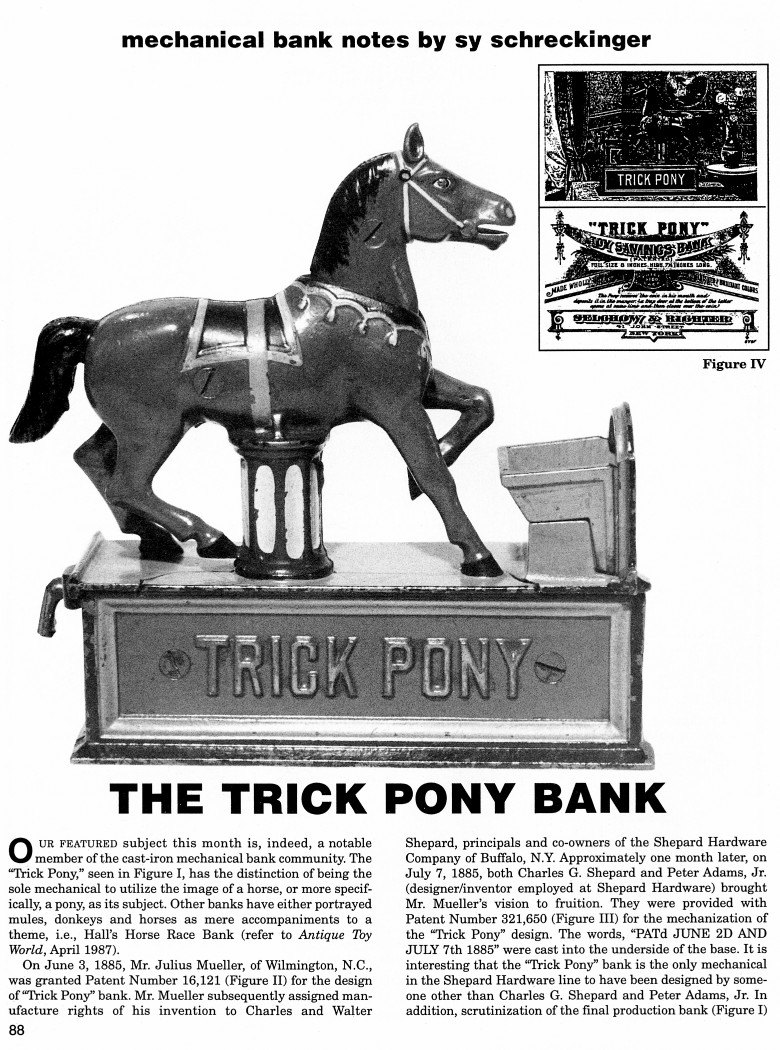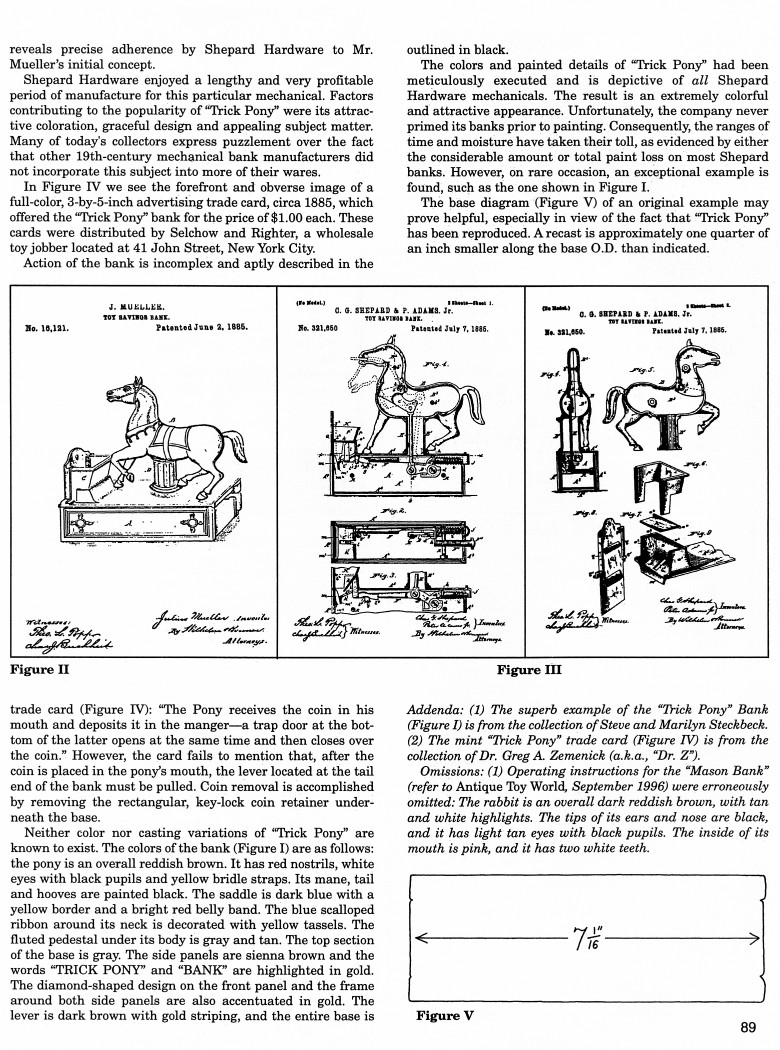|
The Trick Pony Bank
by Sy Schreckinger – ANTIQUE TOY WORLD Magazine – November, 1996
Our featured subject this month is, indeed, a
notable member of the cast-iron mechanical bank community. The "Trick
Pony," seen in Figure I, has the distinction of being the sole mechanical
to utilize the image of a horse, or more specifically, a pony, as its
subject. Other banks have either portrayed mules, donkeys and horses as
mere accompaniments to a theme, i.e., Hall's Horse Race Bank (refer to
Antique Toy World, April 1987).
On June 3, 1885, Mr. Julius Mueller, of Wilmington, N.C., was granted
Patent Number
16,121 (Figure II) for the design of "Trick Pony" bank. Mr.
Mueller subsequently assigned manufacture rights of his invention to
Charles and Walter Shepard, principals and co-owners of the Shepard
Hardware Company of Buffalo, N.Y. Approximately one month later, on July
7, 1885, both Charles G. Shepard and Peter Adams, Jr. (designer/inventor
employed at Shepard Hardware) brought Mr. Mueller's vision to fruition.
They were provided with Patent Number
321,650 (Figure III) for the
mechanization of the "Trick Pony" design. The words, "PATd JUNE 2D AND
JULY 7th 1885" were cast into the underside of the base. It is interesting
that the "Trick Pony" bank is the only mechanical in the Shepard Hardware
line to have been designed by someone other than Charles G. Shepard and
Peter Adams, Jr. In addition, securitization of the final production bank
(Figure I) reveals precise adherence by Shepard Hardware to Mr. Mueller's
initial concept.
Shepard Hardware enjoyed a lengthy and very profitable period of
manufacture for this particular mechanical. Factors contributing to the
popularity of "Trick Pony" were its attractive coloration, graceful design
and appealing subject matter. Many of today's collectors express
puzzlement over the fact that other 19th-century mechanical bank
manufacturers did not incorporate this subject into more of their wares.
In Figure IV we see the forefront and obverse image of a full-color,
3-by-5-inch advertising trade card, circa 1885, which offered the "Trick
Pony" bank for the price of $1.00 each. These cards were distributed by
Selchow and Righter, a wholesale toy jobber located at 41 John Street, New
York City.
Action of the bank is incomplex and aptly described in the trade card
(Figure IV): "The Pony receives the coin in his mouth and deposits it in
the manger — a trap door at the bottom of the latter opens at the same time
and then closes over the coin." However, the card fails to mention that,
after the coin is placed in the pony's mouth, the lever located at the
tail end of the bank must be pulled. Coin removal is accomplished by
removing the rectangular, key-lock coin retainer underneath the base.
Neither color nor casting variations of "Trick Pony" are known to
exist. The colors of the bank (Figure I) are as follows: the pony is an
overall reddish brown. It has red nostrils, white eyes with black pupils
and yellow bridle straps. Its mane, tail and hooves are painted black. The
saddle is dark blue with a yellow border and a bright red belly band. The
blue scalloped ribbon around its neck is decorated with yellow tassels.
The fluted pedestal under its body is gray and tan. The top section of the
base is gray. The side panels are sienna brown and the words "TRICK PONY"
and "BANK" are highlighted in gold. The diamond-shaped design on the front
panel and the frame around both side panels are also accentuated in gold.
The lever is dark brown with gold striping, and the entire base is
outlined in black.
The colors and painted details of "Trick Pony" had been meticulously
executed and is depictive of all Shepard Hardware mechanicals. The result
is an extremely colorful and attractive appearance. Unfortunately, the
company never primed its banks prior to painting. Consequently, the ranges
of time and moisture have taken their toll, as evidenced by either the
considerable amount or total paint loss on most Shepard banks. However, on
rare occasion, an exceptional example is found, such as the one shown in
Figure I.
The base diagram (Figure V) of an original example may prove helpful,
especially in view of the fact that "Trick Pony" has been reproduced. A
recast is approximately one quarter of an inch smaller along the base O.D.
than indicated.
Addenda: (1) The superb example of the "Trick Pony" Bank (Figure I)
is from the collection of Steve and Marilyn Steckbeck. (2) The mint "Trick
Pony" trade card (Figure IV) is from the collection of Dr. Greg A.
Zemenick (a.k.a., "Dr. Z").
Correction: (from
January, 1997) Please note: Due to editorial errors in the
"Omissions" section which followed the "Trick Pony Bank" article, Antique
Toy World, November 1996, the paragraphs which NOW follow replace that
section.
Omissions: (1) Operating instructions for the "Mason Bank"
(refer to Antique Toy World,
August 1984) were erroneously omitted: A coin
is placed into the hod and the lever is then pressed. Simultaneously, the
hod tilts forward, the money falls through an opened trap door section
behind the brick wall, and the mason raised his trowel and brick. Deposits
are retrieved by removing the rectangular, key-lock coin retainer
underneath the base.
|


